For more information and search capabilities visit: Lessons Main Index Page
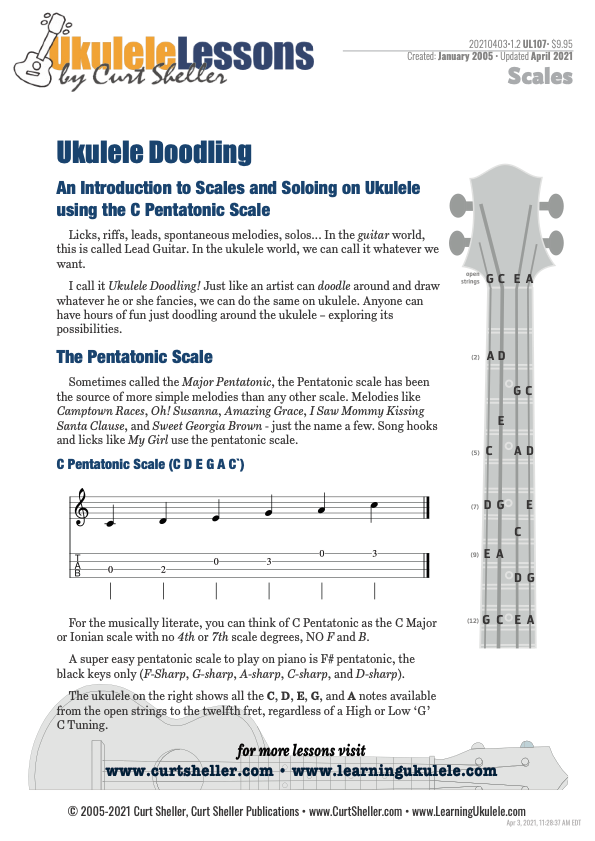
An "Introduction to Scales and Soloing on Ukulele" using the C Pentatonic Scale. Taking what you might already know and using it in different ways. Exploring the entire ukulele fingerboard have hours of fun just doodling around and exploring the ukulele's possibilities.
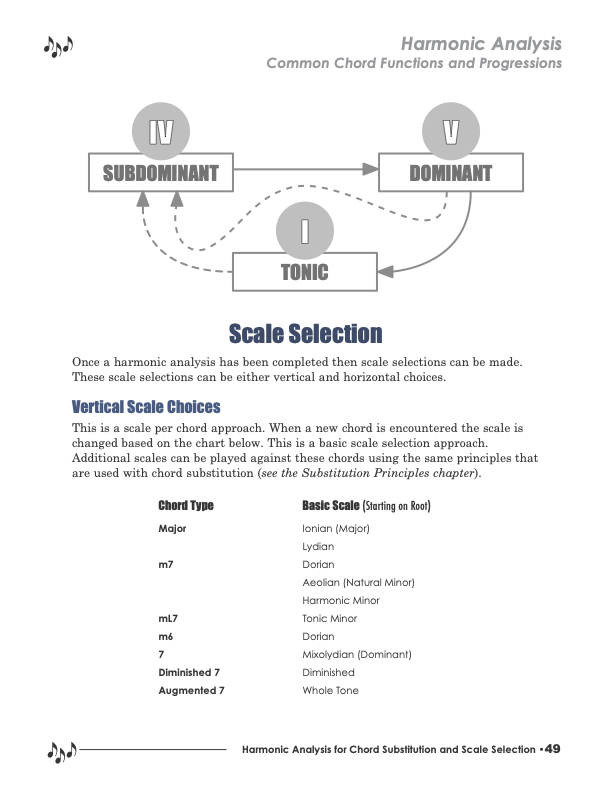
A Harmonic Analysis is then used to make vertical and horizontal scale selection for improvisation and chord substitution.
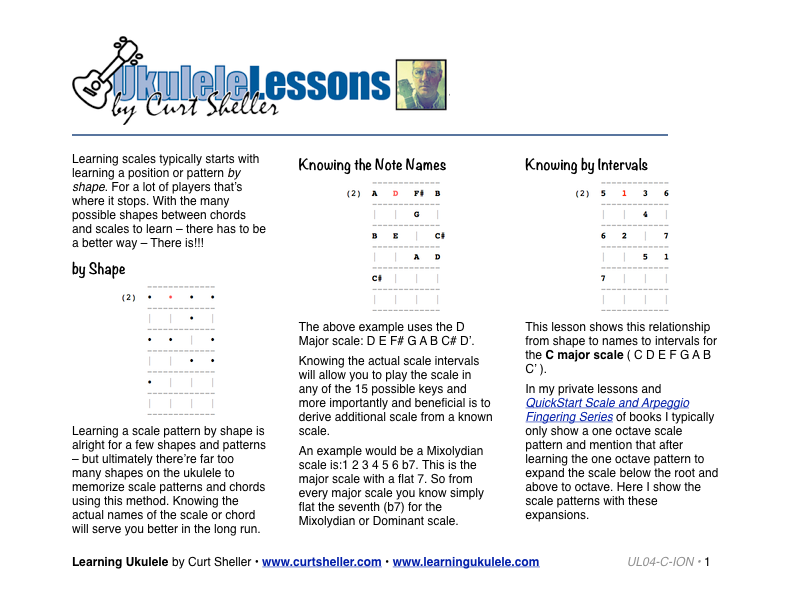
Essential C Major scale patterns for ukulele. Learning scales typically starts with learning a position or pattern by shape. For a lot of players that‘s where it stops. With the many possible shapes between chords and scales to learn - there has to be a better way - There is!!!
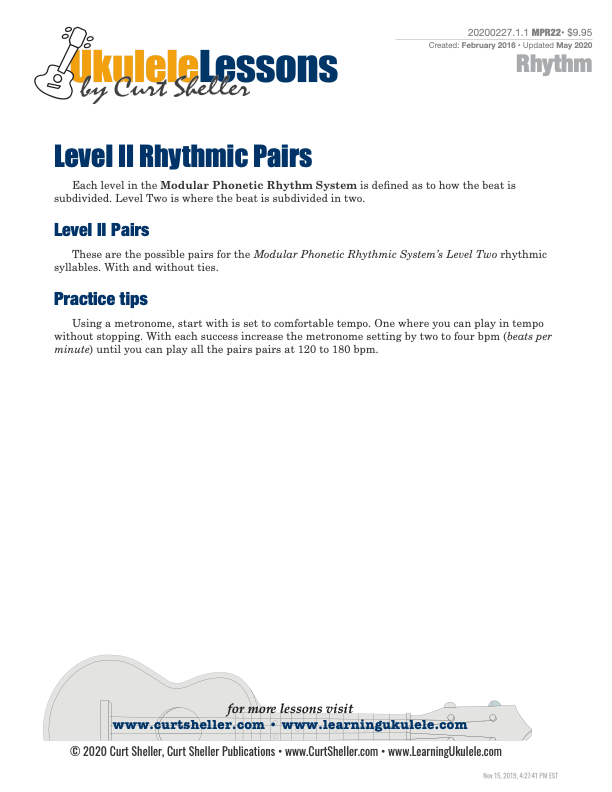
Develop your ukulele strums vocabulary and sharpen your reading chops with the "Level II, Modular Phonetic Rhythmic Syllables — Pairs Worksheet".
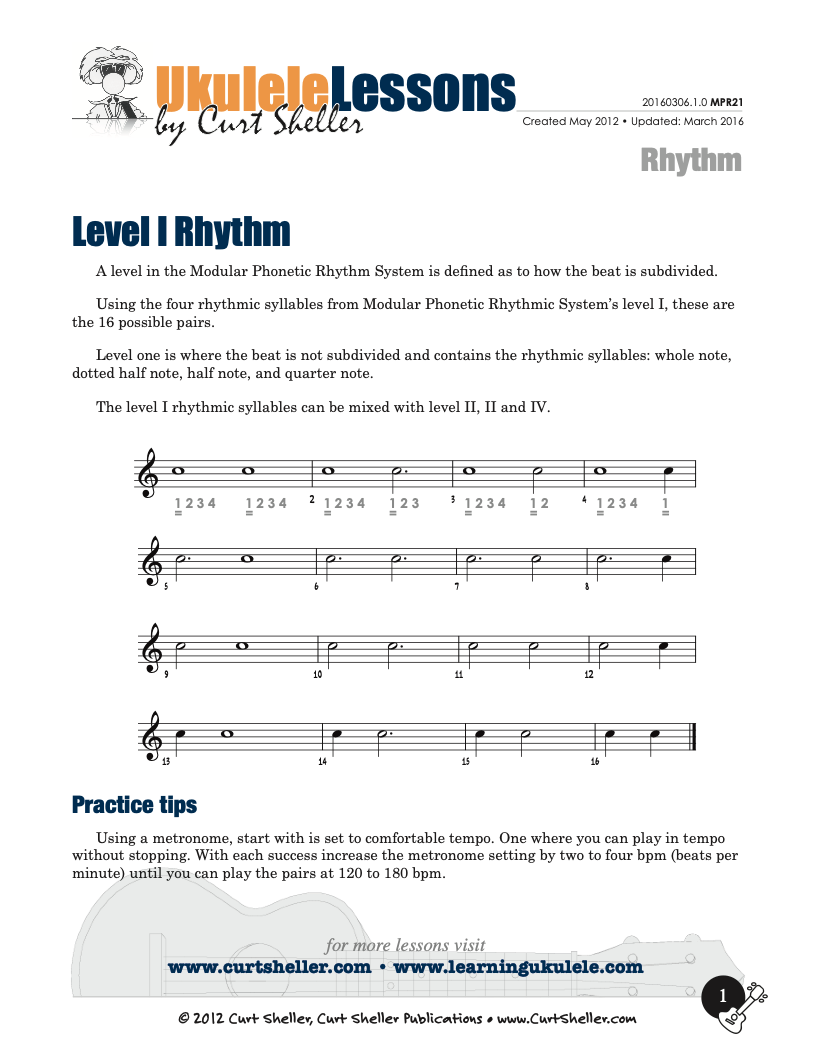
Develop your ukulele strums vocabulary and sharpen your reading chops with the "Level I, Modular Phonetic Rhythmic Syllables — Pairs Worksheet".
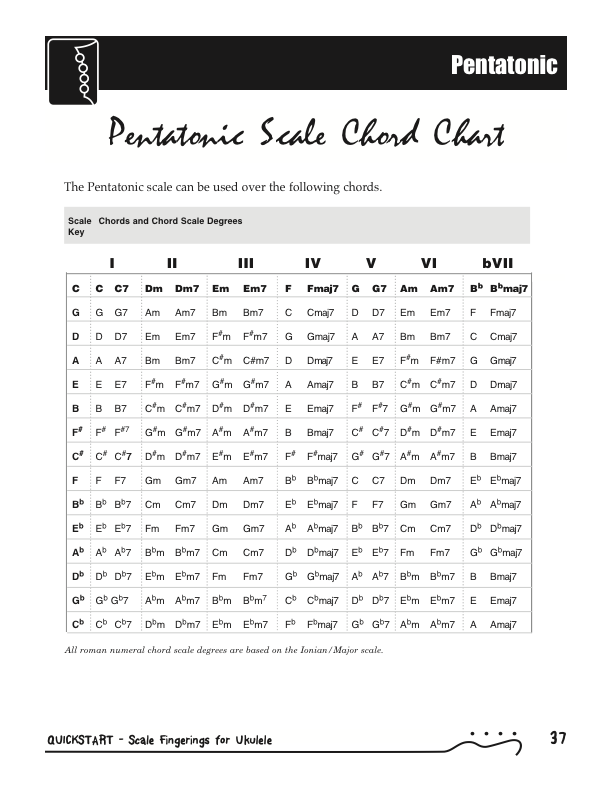
The Pentatonic/Major Pentatonic scale is one of the six essential scales that every ukulele player should know. Here are the chords for all 15 Pentatonic/Major Pentatonic scales.
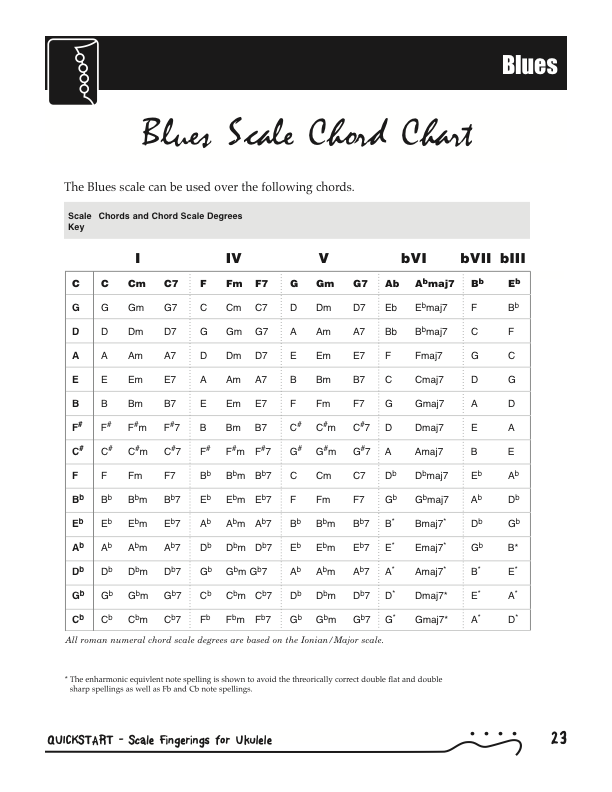
The Blues/MInor Pentatonic scale is one of the six essential scales that every ukulele player should know. Here are the chords for all 15 Pentatonic/Major Pentatonic scales.
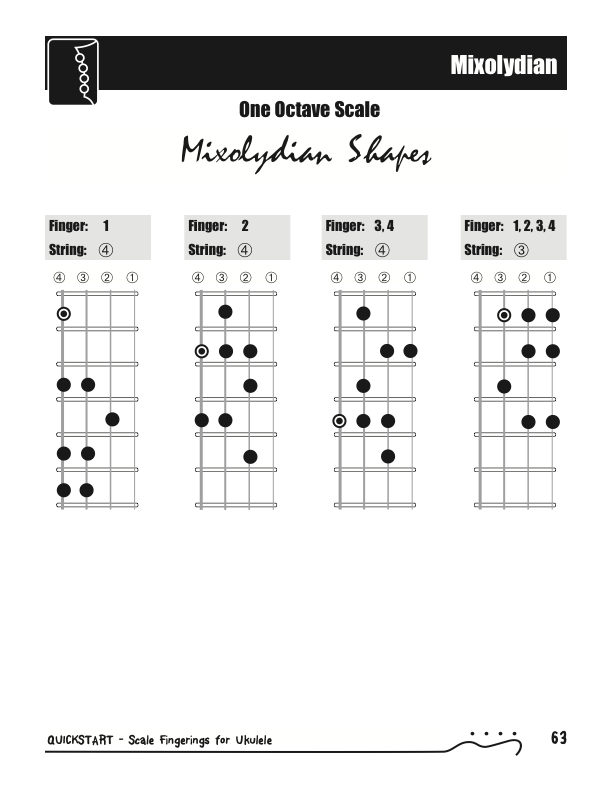
QuickStart scale shapes summary for "Mixolydian/Dominant", one of the six essential scales that every ukulele player should know.
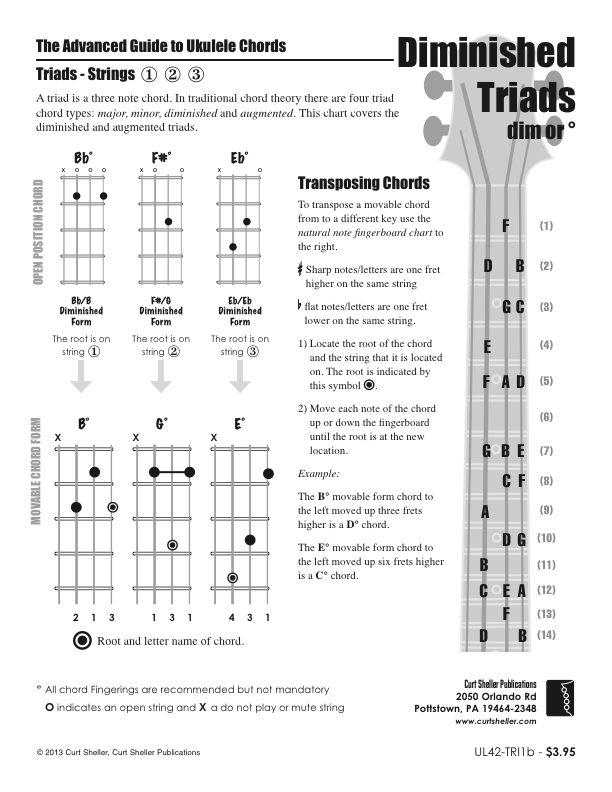
A triad is a three note chord. In traditional chord theory there are four triad chord types: major, minor, diminished and augmented. This lesson covers the augmented and diminished triads on strings 1 2 3.
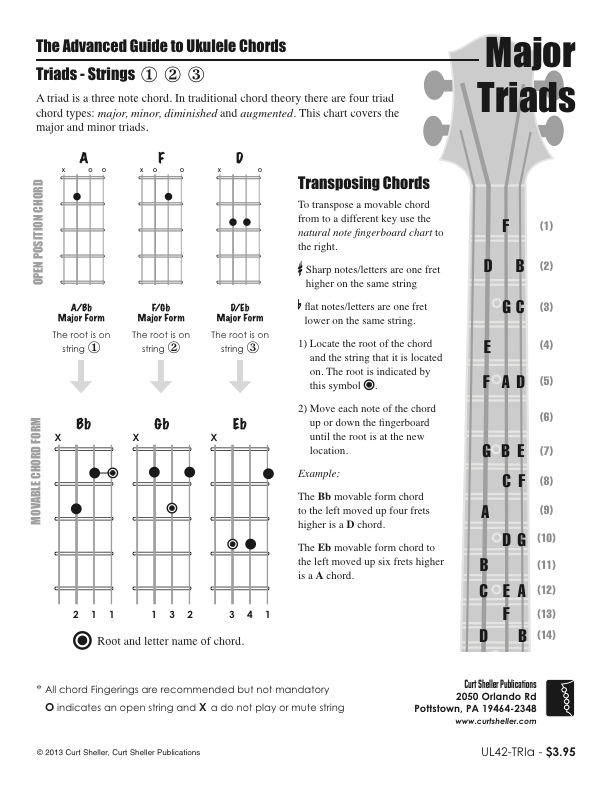
A triad is a three note chord. In traditional chord theory there are four triad chord types: major, minor, diminished and augmented. This lesson covers the major and minor triads on string 1 2 3.

A triad is a three note chord. In traditional chord theory there are four triad chord types: major, minor, diminished and augmented. This chart covers the major and minor triads on strings 2 3 4.
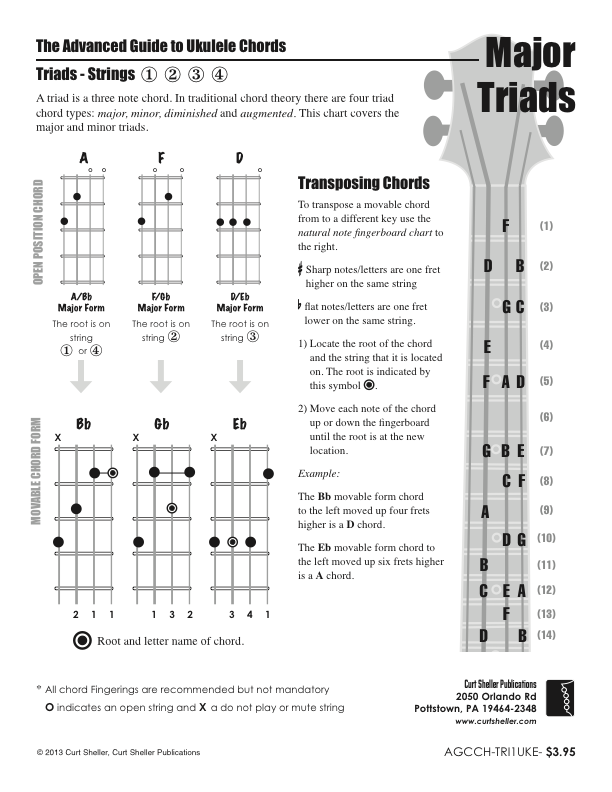
A triad is a three note chord. In traditional chord theory there are four triad chord types: major, minor, diminished and augmented. This chart covers the major and minor triads on strings 1 2 3 4.
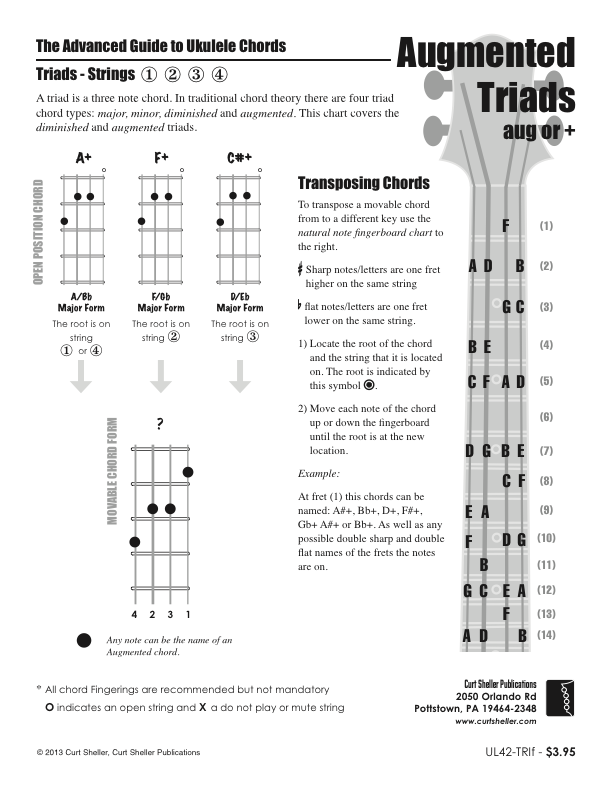
A triad is a three note chord. In traditional chord theory there are four triad chord types: major, minor, diminished and augmented. This lesson covers the augmented and diminished triads on strings 1 2 3 4.
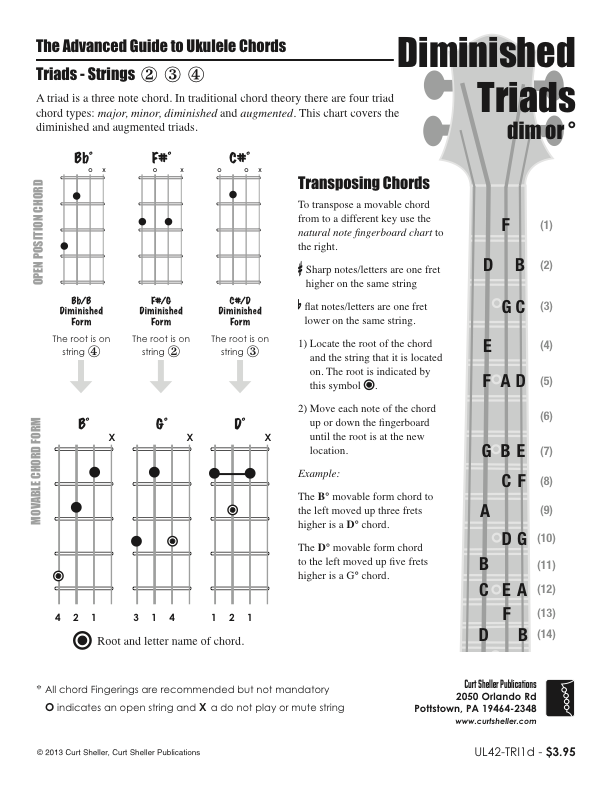
A triad is a three note chord. In traditional chord theory there are four triad chord types: major, minor, diminished and augmented. This lesson covers the augmented and diminished triads on strings 2 3 4.
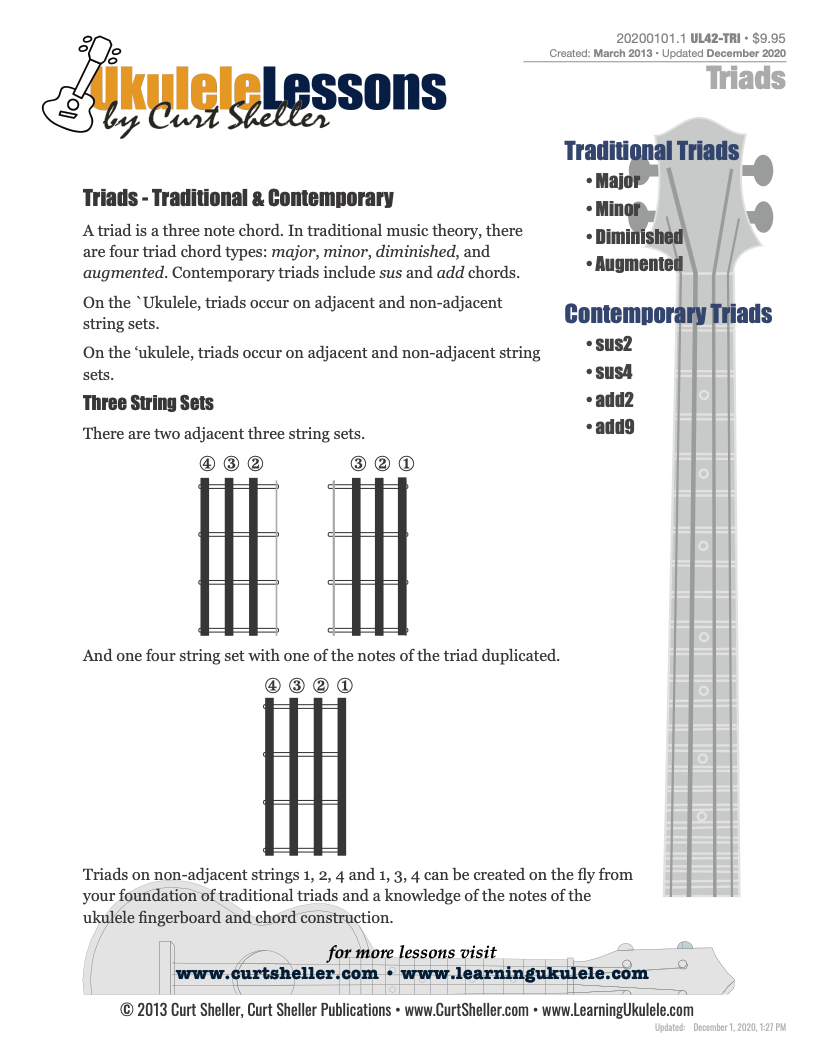
A "Triad" is a three note chord. In traditional music theory, there are four triad chord types: major, minor, diminished, and augmented. Contemporary triads include sus and add.
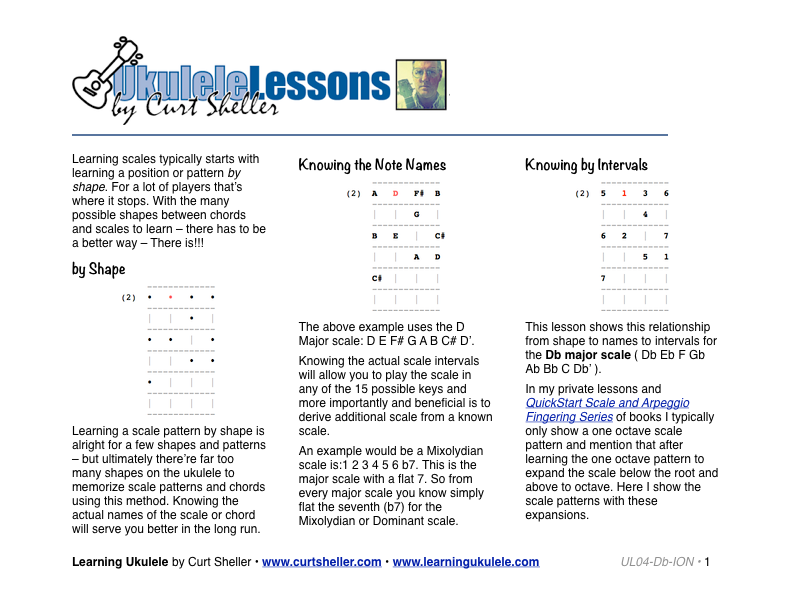
Essential DbMajor scale patterns for ukulele. Learning scales typically starts with learning a position or pattern by shape. For a lot of players that's where it stops. With the many possible shapes between chords and scales to learn – there has to be a better way – There is!!!
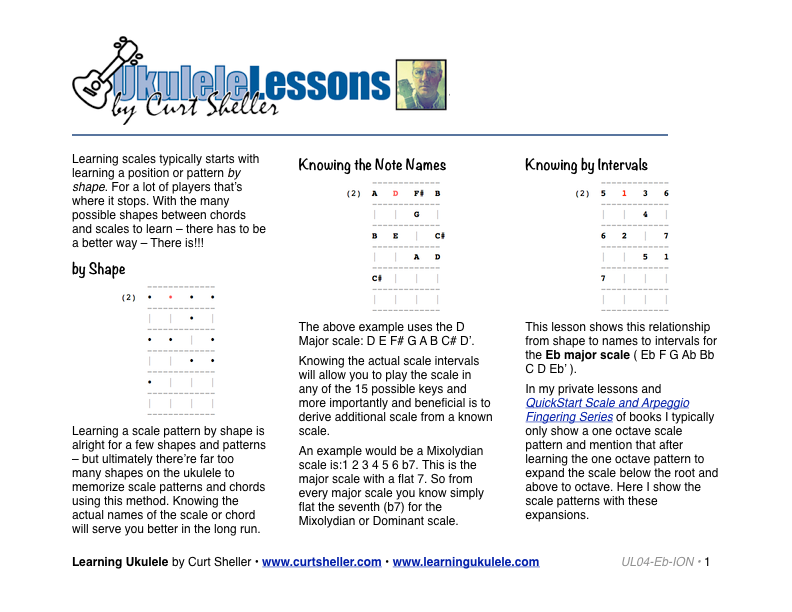
Essential Eb Major scale patterns for ukulele. Learning scales typically starts with learning a position or pattern by shape. For a lot of players that's where it stops. With the many possible shapes between chords and scales to learn - there has to be a better way - There is!!!
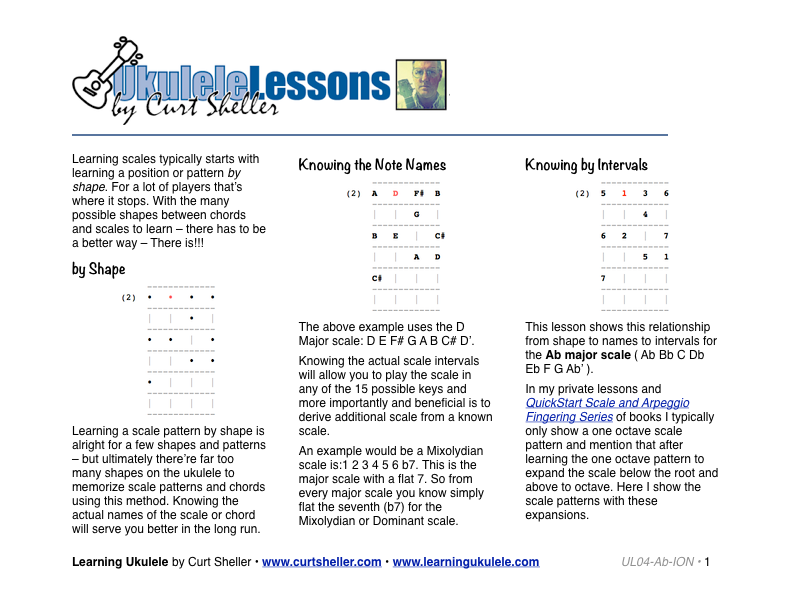
Essential Ab Major scale patterns for ukulele. Learning scales typically starts with learning a position or pattern by shape. For a lot of players that's where it stops. With the many possible shapes between chords and scales to learn - there has to be a better way - There is!!!
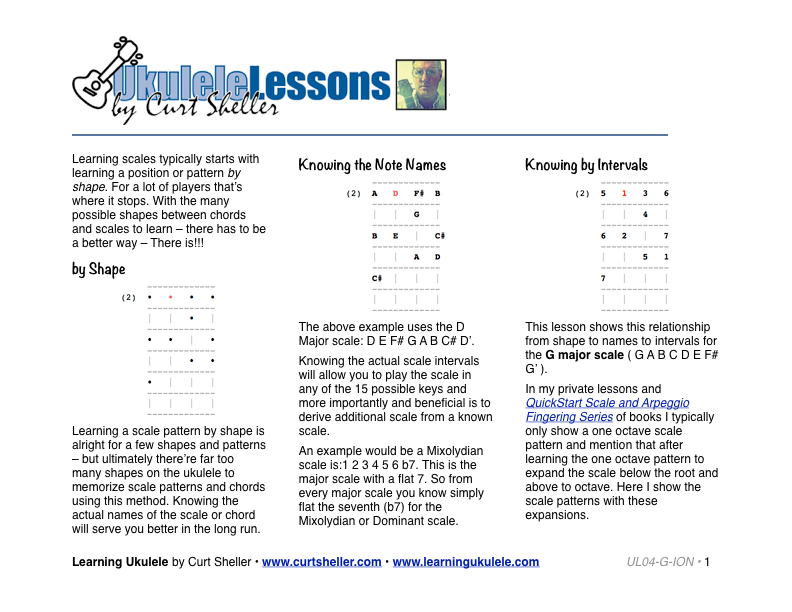
Essential G Major scale patterns for ukulele. Learning scales typically starts with learning a position or pattern by shape. For a lot of players that's where it stops. With the many possible shapes between chords and scales to learn - there has to be a better way - There is!!!

Ukulele Gymnastics series contains quite a few lessons for developing your finger strength and independence of the fretting hand. The fretting hand is responsible for playing chords and single notes. The fretting hand and plucking hand are responsible for getting the music out.
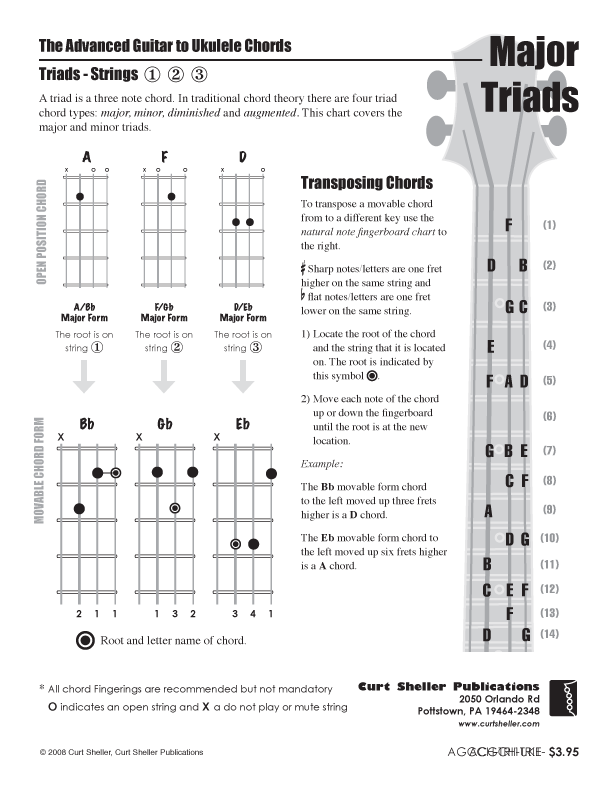
In music or music theory, a triad is a three-note chord (or, more generally, any set of three notes, pitches, or tones). Triads can be used harmonically, as chords and melodically, as single notes. These lessons explore both. Using triads as chords like any other chord and using triads as a basis for creating melodies and improvising.
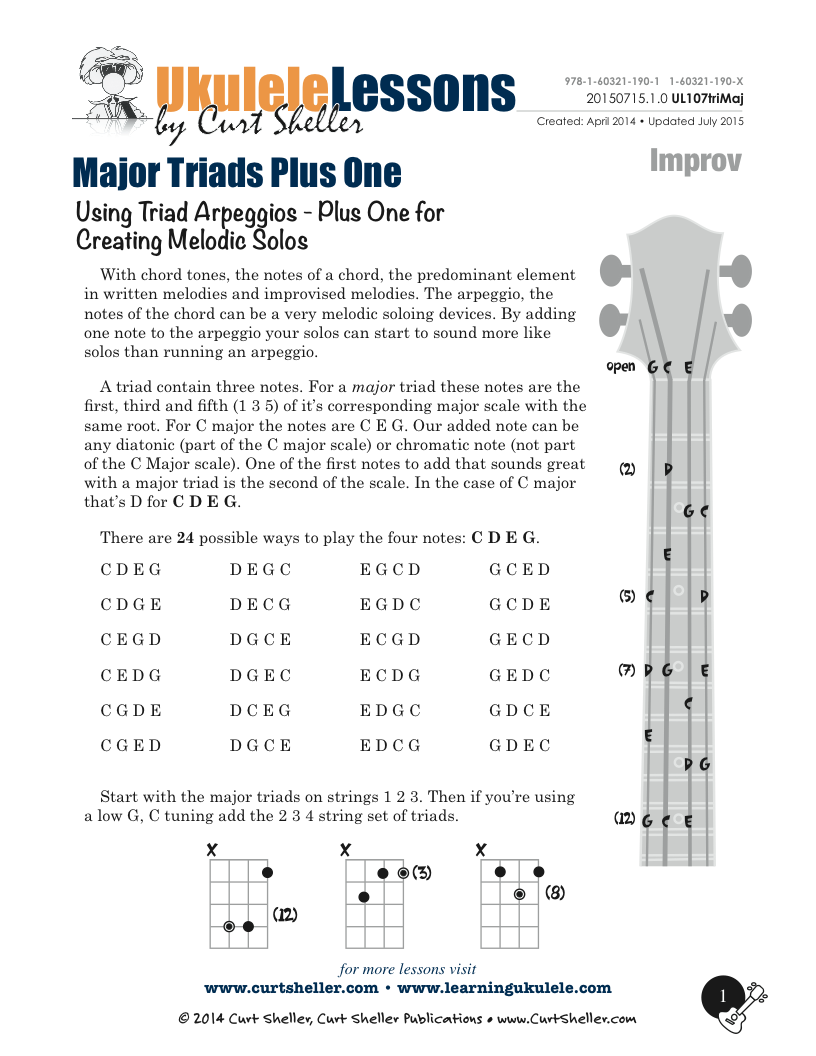
Using Major Triad Arpeggios - Plus One for Creating Melodic Solos. With chord tones, the notes of a chord playing a predominant role in writing melodies and in improvised melodies. The triad plus one additional note is a great melodic device for creating melodies - either written or improvised.
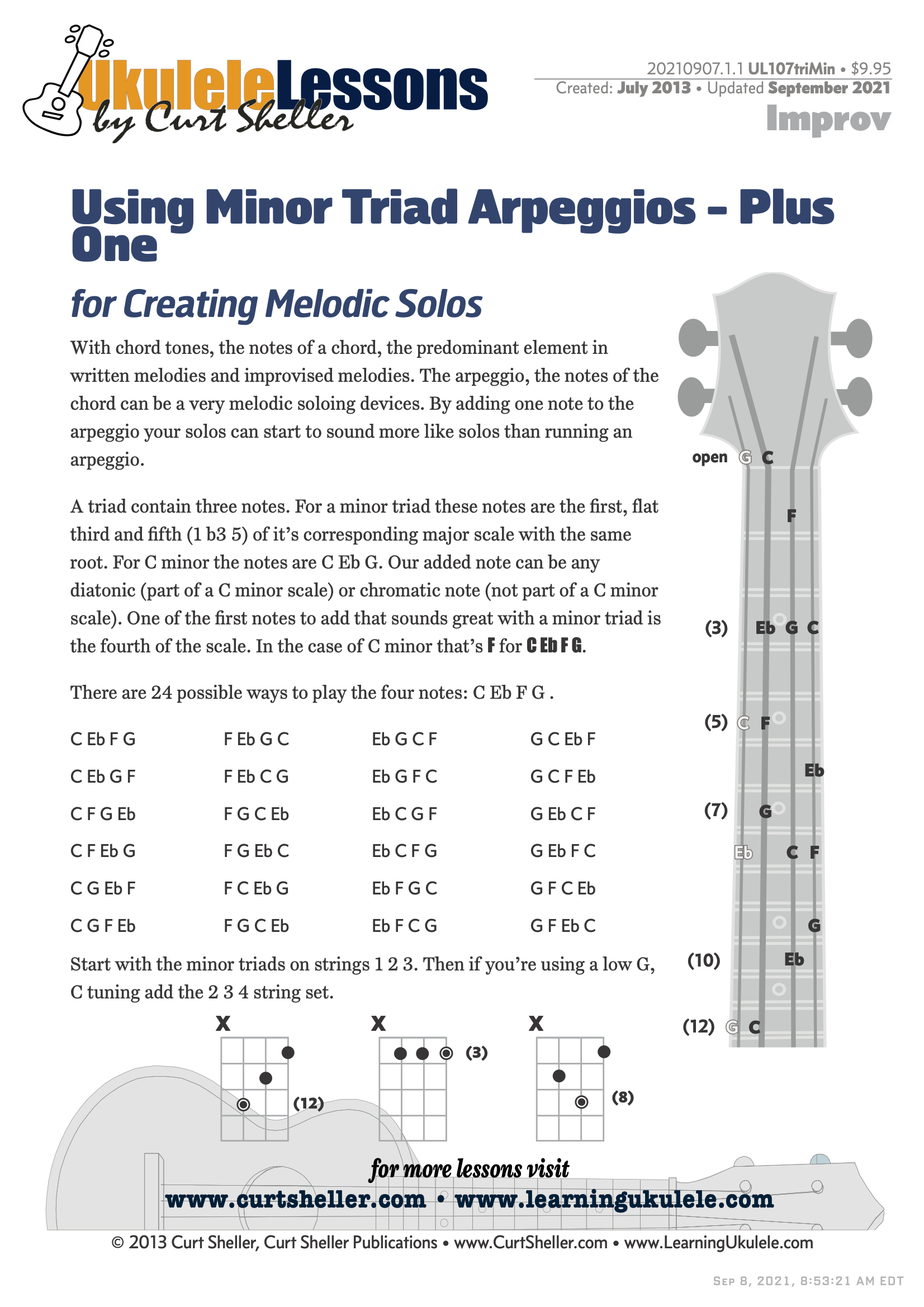
Using Minor Triad Arpeggios - Plus One for Creating Melodic Solos. With chord tones, the notes of a chord playing a predominant role in writing and in and improvised melodies. The triad plus one additional note is a great melodic device for creating melodies - either written or improvised.
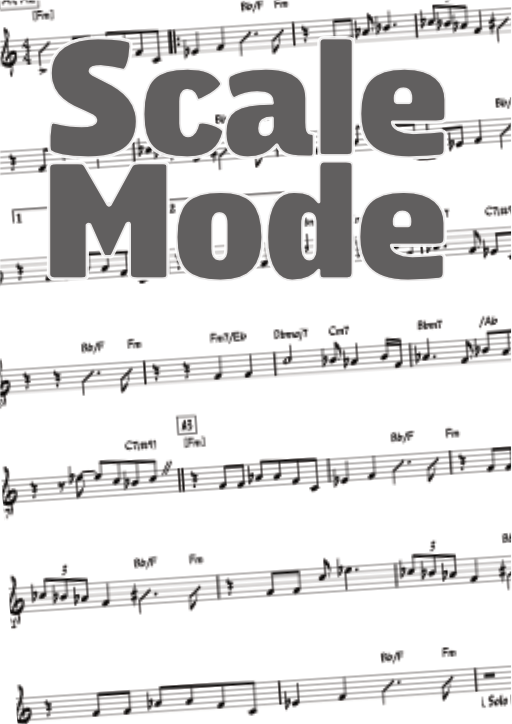
The terms "scale" and "mode" are often used interchangeably, but strictly speaking, there is a significant difference between them in music theory. Although they may share the same set of notes, a scale and a mode or modal scale are not the same thing. It's important to note that a scale and a mode can contain the same notes.
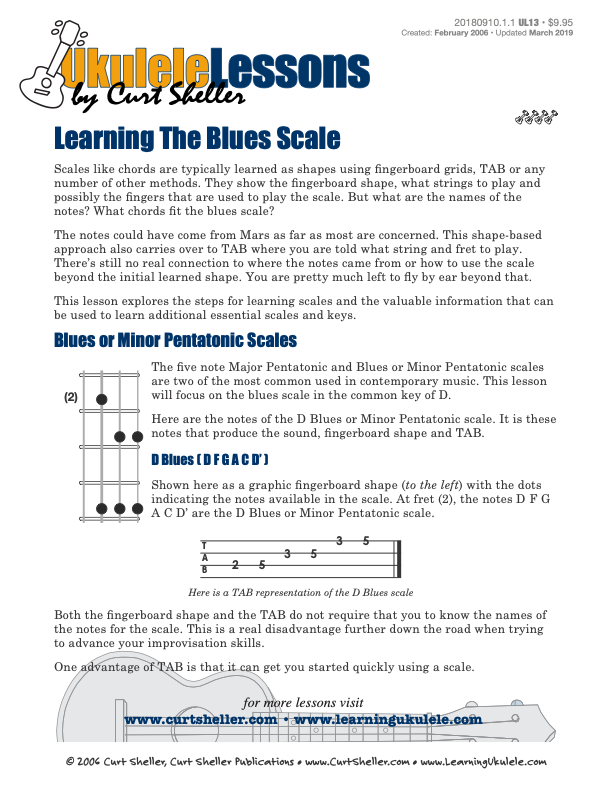
Learn the Blues ( Minor Pentatonic ) and Pentatonic ( Major Pentatonic ) scales on ukulele. A practical approach to learning theses two essential scales using the Blues. These five note scales, the Major Pentatonic and the Blues or Minor Pentatonic scales are two of the most common scales used in contemporary music.
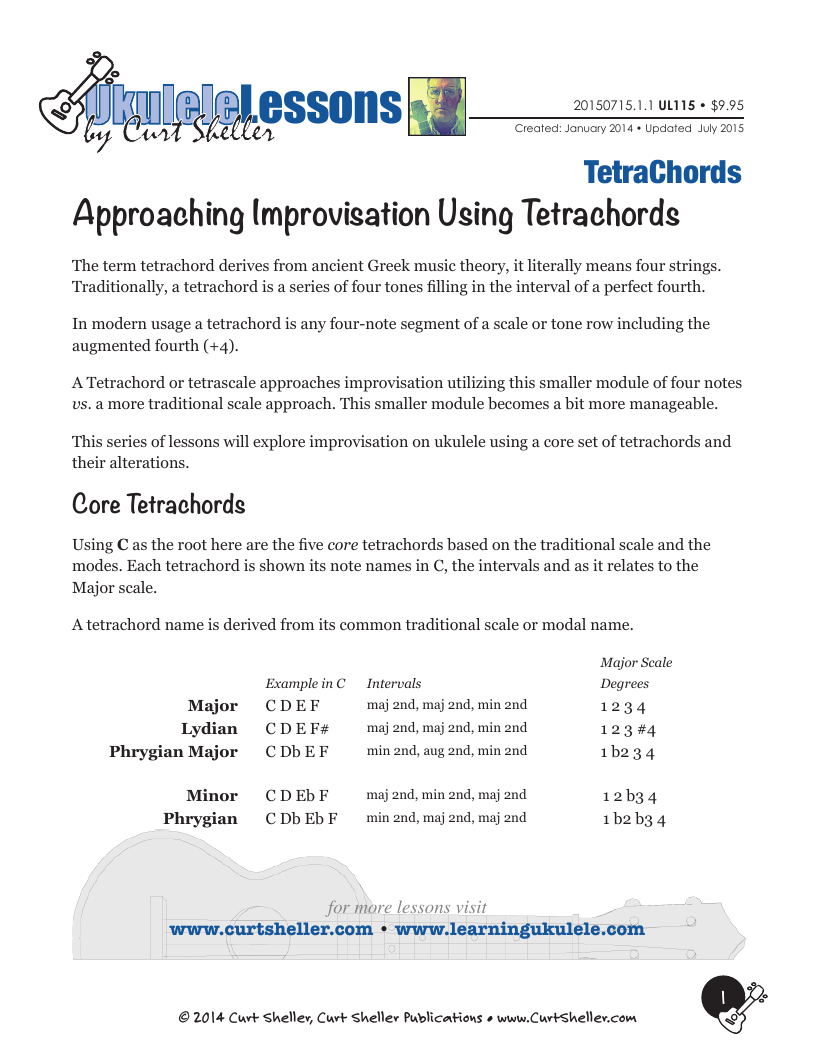
Traditionally, a "Tetrachord" is a series of four tones filling in the interval of a perfect fourth. In modern usage a tetrachord is any four-note segment of a scale or tone row including the augmented fourth (+4). The term tetrachord derives from ancient Greek music theory, it literally means four strings.**
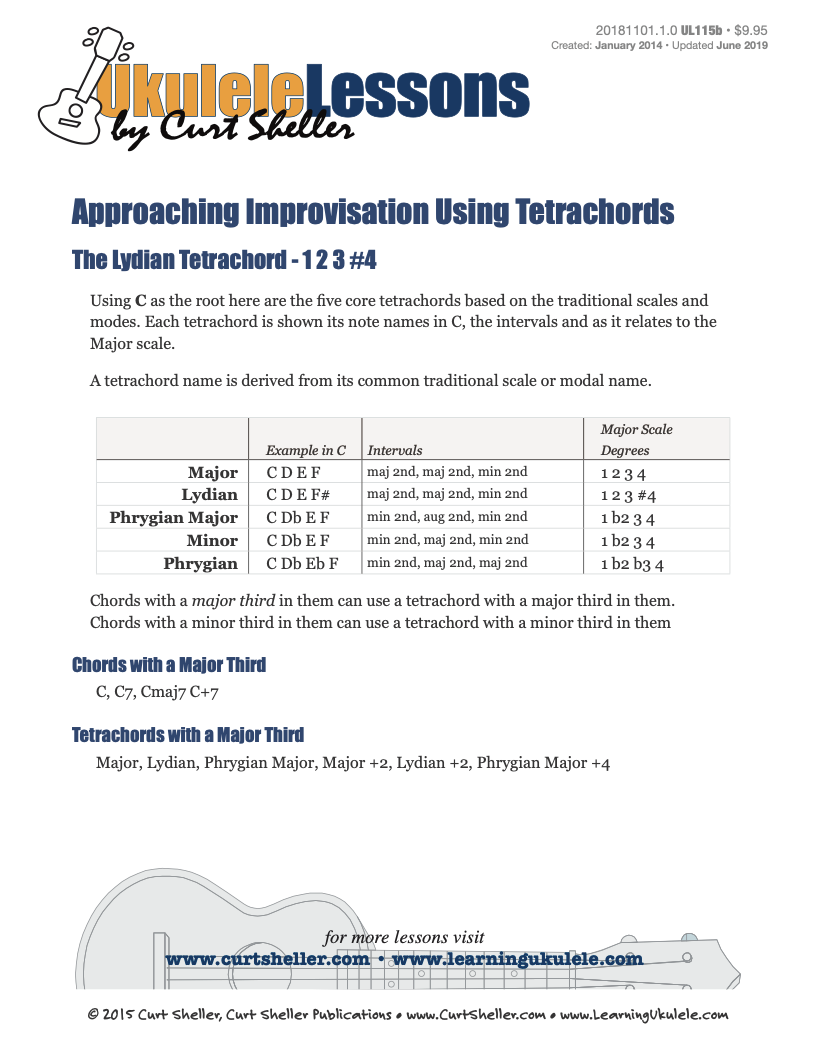
The Lydian tetrachord is the 1 2 3 #4 of a Lydian, Lydian Dominant, or Whole Tone scale.
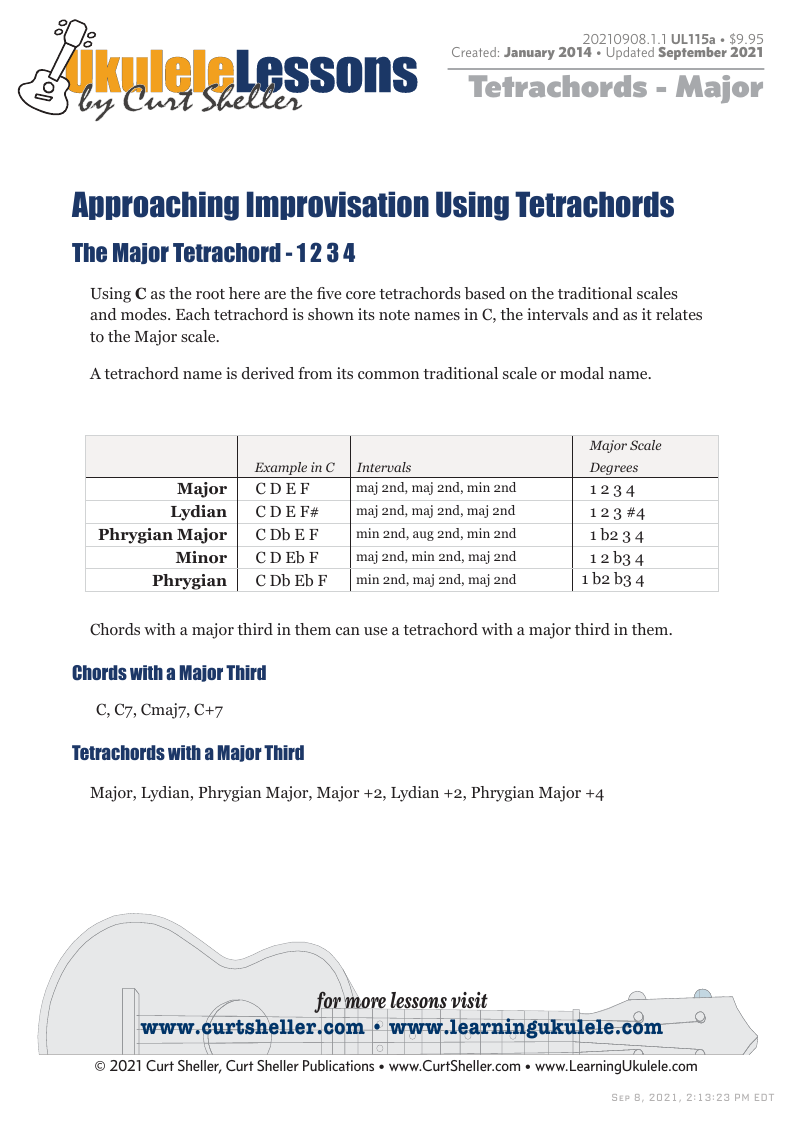
The Major tetrachord is the 1 2 3 4 of a Ionian (Major), or Mixolydian (Dominant) scale.
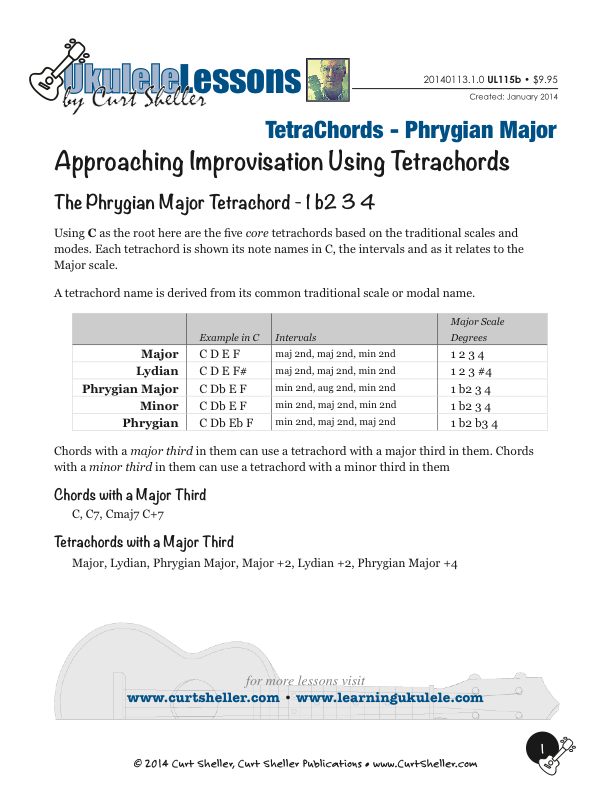
The Phrygian Major tetrachord is the 1 b2 3 4 of a Phrygian scale.
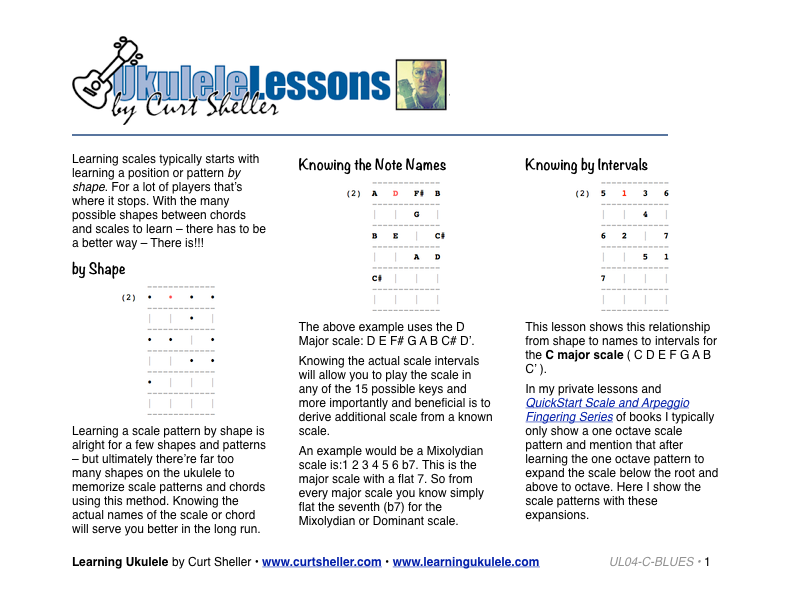
Essential C Blues/Minor Pentatonic scale patterns for ukulele.
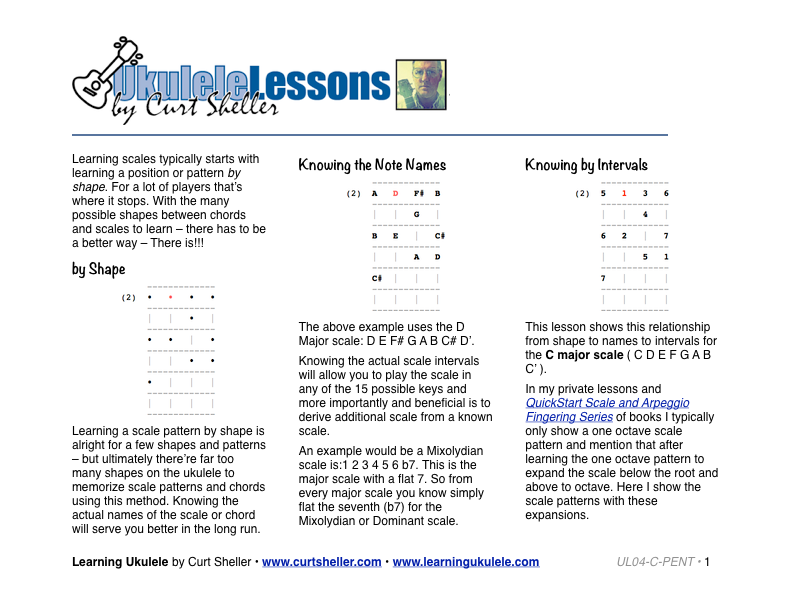
Essential C Pentatonic or Major Pentatonic scale patterns for ukulele. Learning scales typically starts with learning a position or pattern by shape. For a lot of players that's where it stops. With the many possible shapes between chords and scales to learn - there has to be a better way - There is!!!
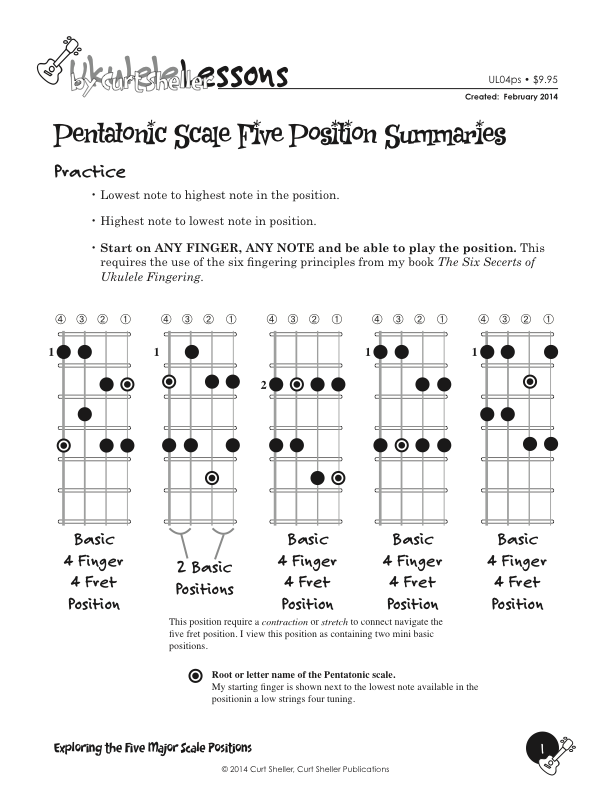
The five pentatonic scale positions - a summary. This is the first steps for most players in learning the pentatonic scales in various positions on the neck.
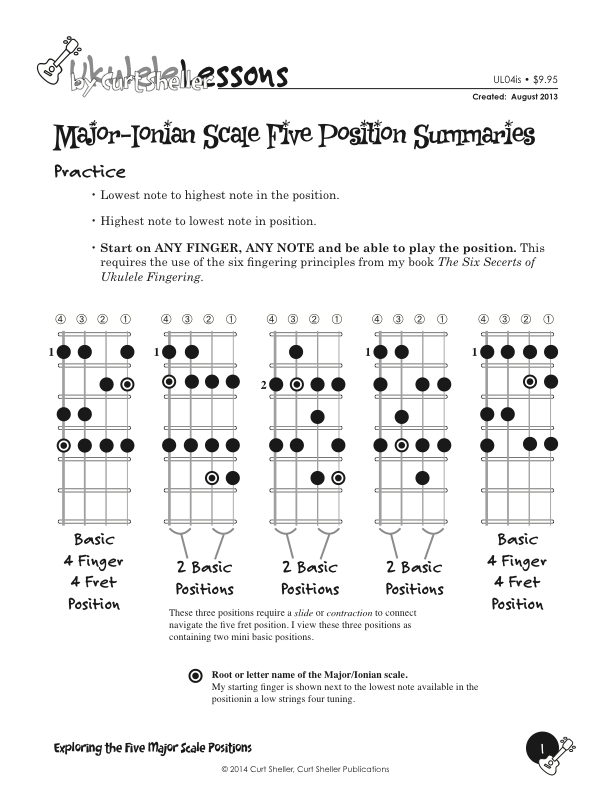
The five "Major/Ionian" scale positions — a summary. The five basic positions are simply the expansion above and below the root and octave of the one octave scale fingerings using the notes that are available in that position. This lesson explores that on the lowest note of the position with every finger.

Building on the Major Triad Arpeggios - Plus One for Creating Melodic Solos lesson you can add a b7 to a major triad for a 4-part Seventh chord. With chord tones, the notes of a chord playing a predominant role in writing melodies and in improvised melodies. The triad plus one additional note is a great melodic device for creating melodies - either written or improvised.
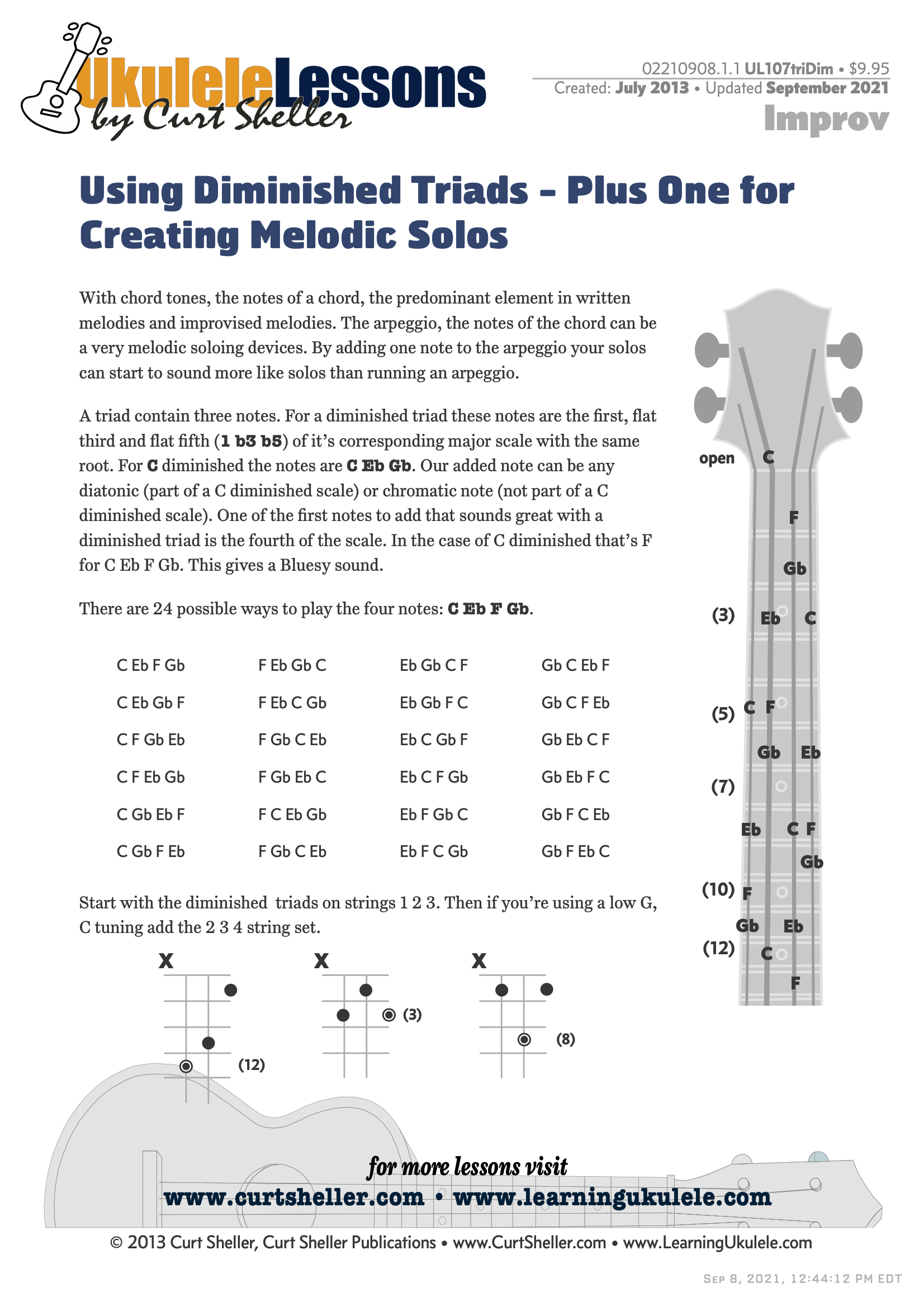
Using Diminished Triad Arpeggios - Plus One for Creating Melodic Solos. With chord tones, the notes of a chord playing a predominant role in writing melodies and in improvised melodies. The triad plus one additional note is a great melodic device for creating melodies - either written or improvised.

Using Augmented Triad Arpeggios - Plus One for Creating Melodic Solos. With chord tones, the notes of a chord playing a predominant role in writing melodies and in improvised melodies. The triad plus one additional note is a great melodic device for creating melodies - either written or improvised.
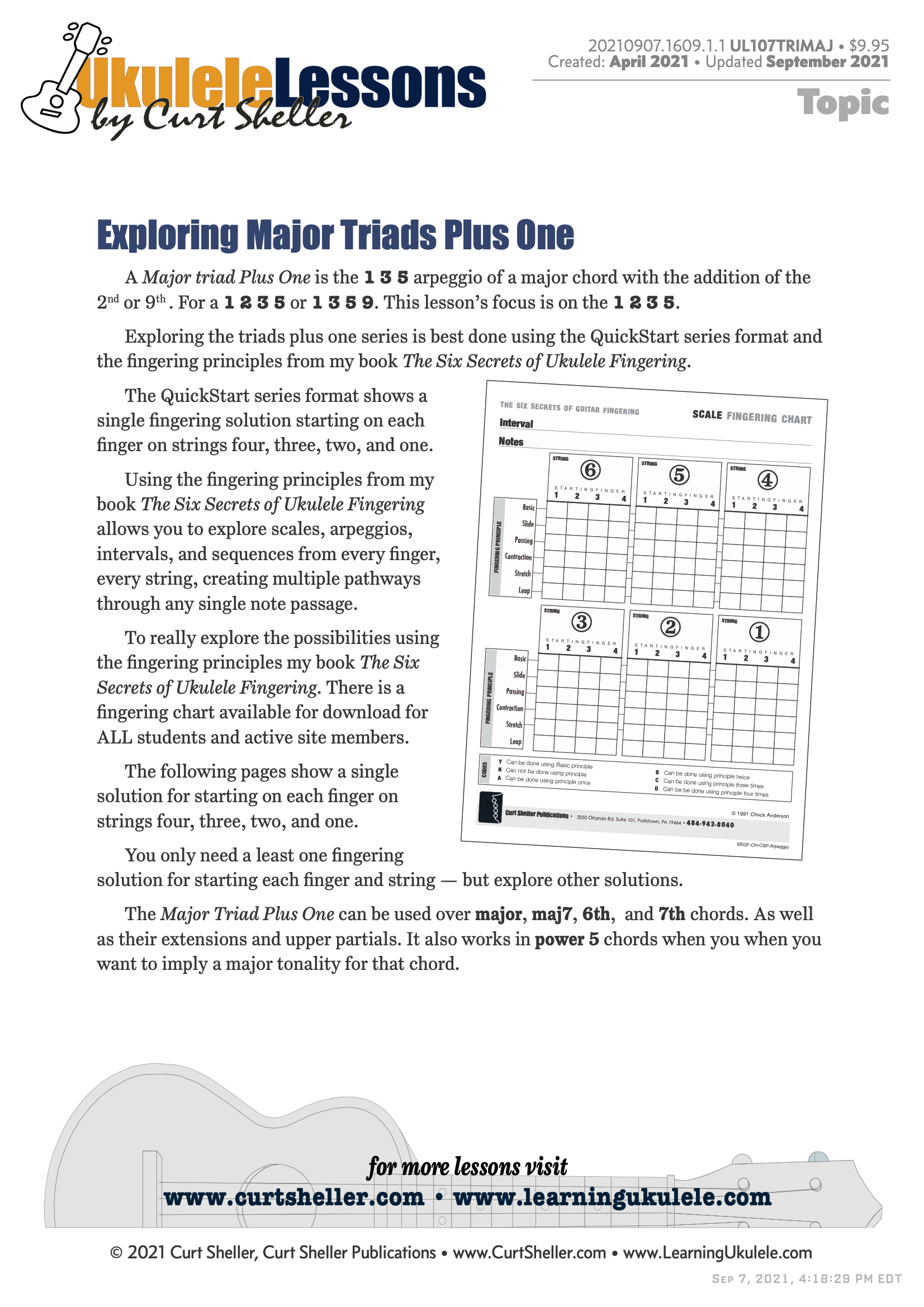
Exploring the triads plus one series is best done using the QuickStart series format and the fingering principles from my book The Six Secrets of Ukulele Fingering. The QuickStart series format single fingering solution for starting on each finger on strings four, three, two and one. Using the fingering principles from my book The Six Secrets of Ukulele Fingering allows you to explore scales, arpeggios, intervals and sequences from every finger-every strings, creating multiple pathways through any single note passage.

The Minor tetrachord is the 1 2 b3 4 of a Aeolian (Natural Minor) scale.

For Lesson Eight we'll add and build on the lesson and material from lesson four.

A metronome is a device that produces an audible click or other sound at a regular interval that can be set by the user, typically in beats per minute (bpm).
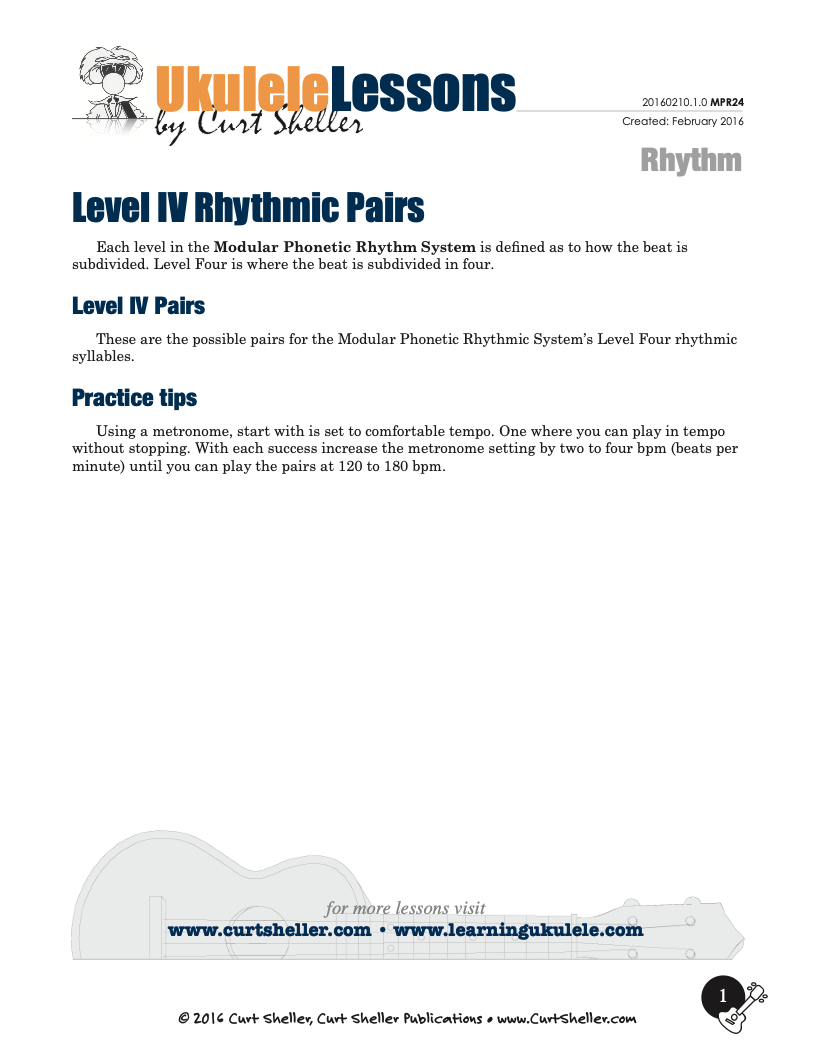
Level IV rhythmic syllable pairs for developing your ukulele strums vocabulary and sharpen your reading chops.


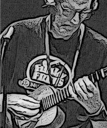
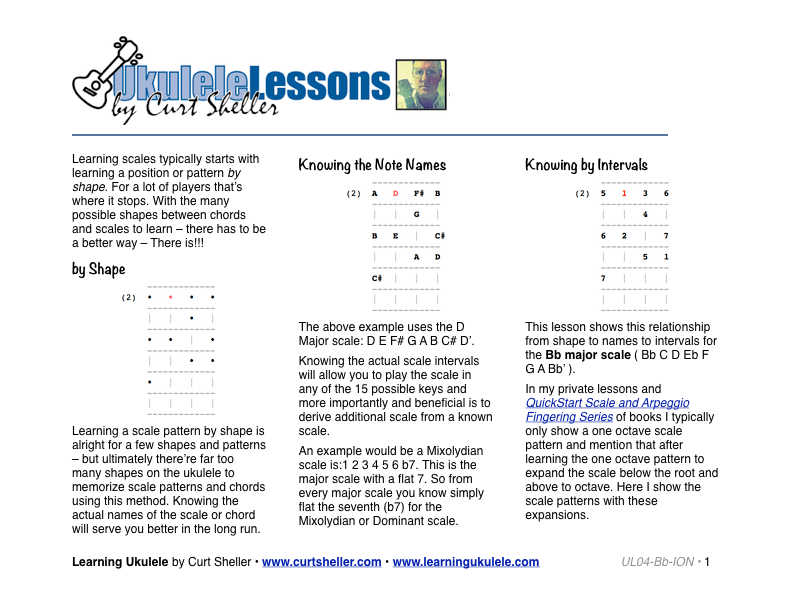
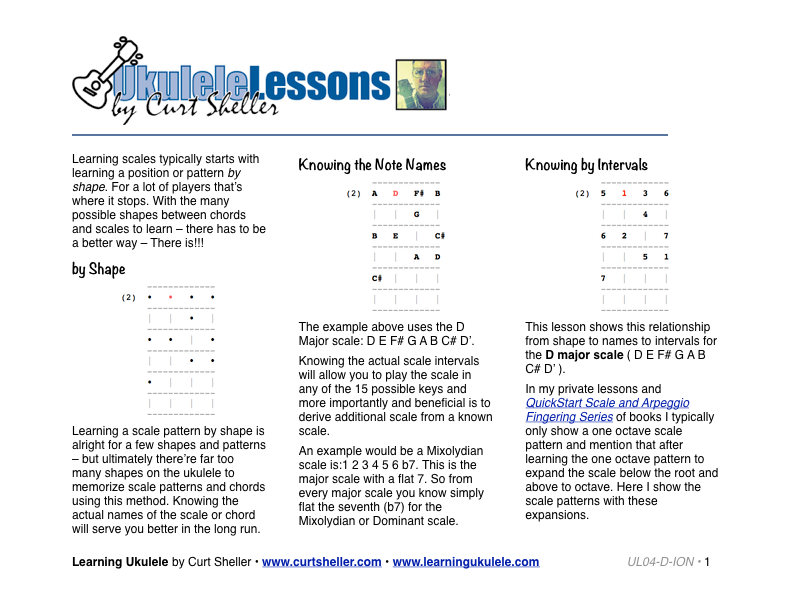


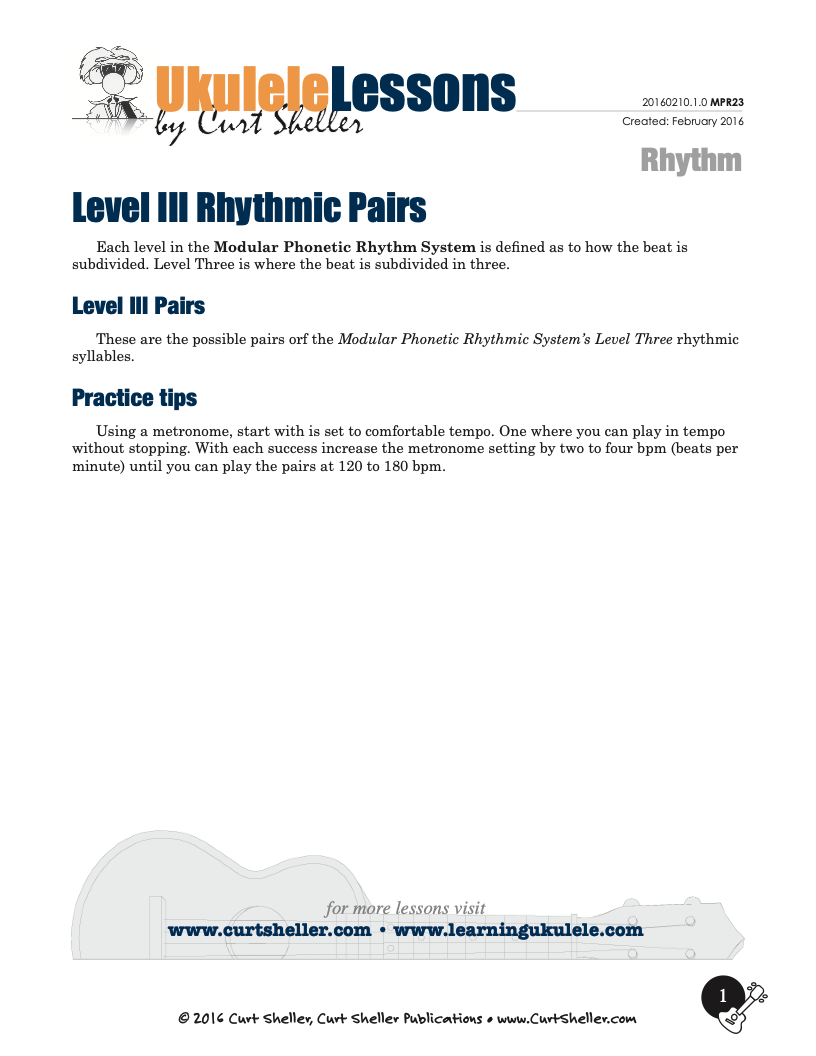
.jpg)